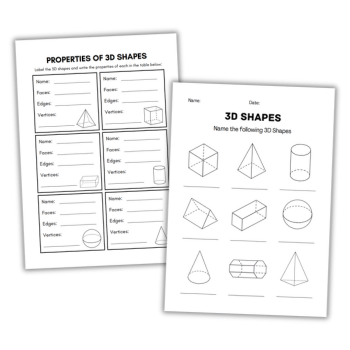These two worksheets focus on 3D shapes. Use them in KS1 and KS2 primary maths lessons. They provide an excellent opportunity for hands-on learning about the names and properties of 3D shapes.
Naming 3D shapes worksheet
This worksheet asks pupils to identify and name a range of 3D shapes. This includes cubes, spheres, cones, cylinders and more complex shapes like hexagonal prisms and tetrahedrons.
It’s perfect for introducing pupils in Years 2 and 3 to the vocabulary of 3D shapes, aligning with the Year 2 curriculum’s emphasis on recognising common 3D shapes and the Year 3 curriculum’s focus on describing properties of shapes.
The inclusion of an answer key supports independent learning, enabling children to self-check their work or allowing teachers to use it for quick marking.
Properties of 3D shapes worksheet
This worksheet delves deeper into the geometry of 3D shapes by asking pupils to label shapes and record their properties – the number of faces, vertices and edges.
This activity aligns well with the Year 3 and Year 4 curriculum, which introduces describing and classifying 3D shapes by their properties.
It encourages mathematical reasoning and vocabulary building, as pupils consider the structure of each shape. This activity can also be adapted for Year 5 pupils when revisiting shape properties in more complex contexts.
Suggestions for use
These worksheets can be used flexibly:
- In class: Use them as part of a geometry lesson to reinforce shape recognition and properties.
- Homework: Assign them for independent practice to consolidate learning.
- Assessment: Use the worksheets to check pupils’ understanding at the end of a unit.
Together, these resources provide a comprehensive toolkit for teaching 3D shapes and their properties.
Download a 3D shapes classroom poster pack.











